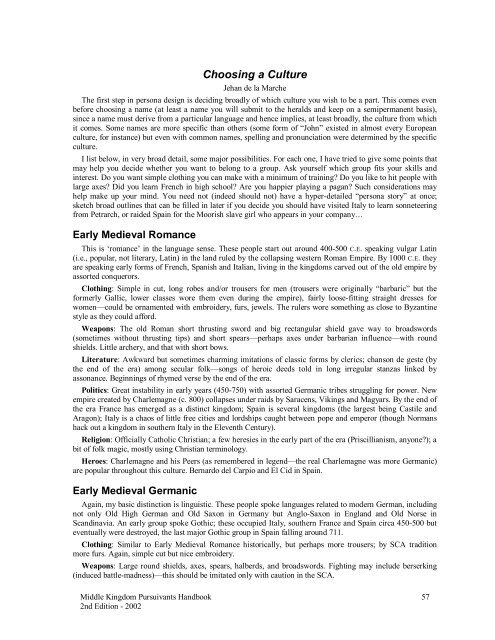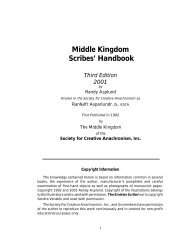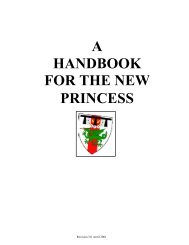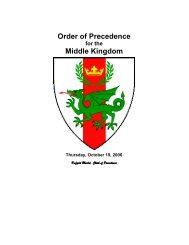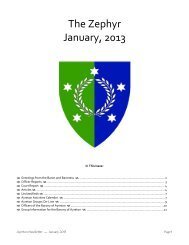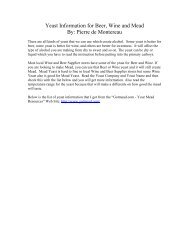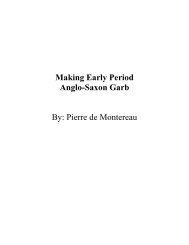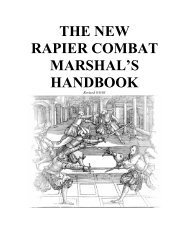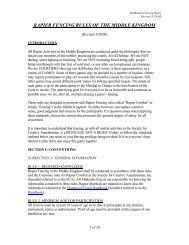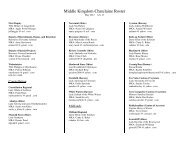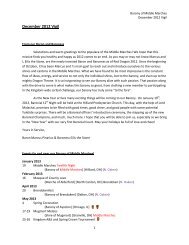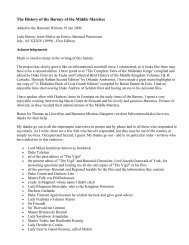6. Names are not limited to one language. They must use languages that could have been used together. AScottish/French name is linguistically valid. A Welsh/Chinese/Hebrew name is not. However, each namepart must be totally of one language. You cannot have a name where the first syllable is from one language,and the second is from another.7. Names may not be offensive or “jokes.” John Nunraper is not allowed, nor would Michael Moose.8. You can not claim status you do not have in the SCA. You cannot use a job description like Healer, Medic,Chirurgeon, etc. unless you have mundane medical certification. You also cannot use a reserved title suchas Pelican, Laurel, Knight, Master, Earl, Duke, Viscountess, etc. unless you have the SCA title/award.9. You must use the full form of the name or a documentably period diminutive. For instance Dickin was usedin period as a diminutive of Richard. Ricky was not.10. If you try and register a spelling variant of a documented spelling, be very careful. Most variants followlinguist rules that vary from language to language, and the documentation required on variants is stricterthan that required on the original names. For instance, the K and C can almost always be usedinterchangeably in Welsh. However, substituting a Q is not linguistically valid.11. Certain names are not allowed even though they were used as during our period. These are names that wereused in history or fiction by such famous people that they have become unique names, since they would beassociated by everyone by the famous holders of those names. Some examples of this type of name wouldinclude names such as Buddha, Gandalf or Jesus.DocumentationName documentation consists of evidence that the name was used as you wish to use it by a mortal, prior tothe year 1600. Evidence should be two photocopies of the page where the reference to the name is found as wellas two photocopies of the title page of the reference. Whatever reference you are using must cite dates. Most“name your baby” type books do not have dates. If the documentation that goes with the name entry consists ofcomments such as “19th century,” “Celtic,” “Teutonic,” etc., it is probably not a good source. A good citationshould consist of an exact year, and usually a first and last name, e.g. John le Smythe 1142, Robert O’Conner1587, etc.There are many good name books, with dates, that are College of Heralds/College of Arms standard. The twothat are used the most, and are the best all around are, for first names, The Oxford Dictionary of ChristianNames by E. G. Withycombe, and for last names A Dictionary of British Surnames by P. H. Reaney. They areexcellent sources, and if you can find the name you are looking for in them, with a pre-1600 date, it will almostdefinitely be acceptable, provided it doesn’t conflict. Unfortunately, they are books on English names—fornames in other languages, other sources are needed. For a list of name books, see the article An Annotated NameBook List.Another good source of name documentation is history books. Going through the index of a history book canprovide lots of good name documentation. Perfectly acceptable first name documentation might consist of acopy of a page that said such-and-such was the name of the fourth duchess of Moscow in 1402.However, when you take a name from historical sources, make sure that you do not duplicate the name ofsomeone famous. This can happen when you are picking a name from a historical source. Remember, peopleduring our period were often known by more than one name. Richard I of England would have been known asRichard Plantagenet, Richard of England, Richard the Lion-Hearted, Richard the Crusader, etc. Translating aname into another language will not necessarily clear it of conflicts. King John of England was known as JohnLackland. Thus the name Jean sans Terre would conflict with King John of England.If you have any questions about adequate documentation or any possible conflicts, go up the Heraldic ladderto a Senior Herald and ask. It is better to ask than to hold on to a submission for too long.Remember, it is easier to start with a correct name than to try to change a name after the submitter and alltheir friends are used to it. People grow attached to their name, and being told they can’t have it frequentlyupsets them. It is our job to ensure that they get what they want whenever possible.Originally published in The Atlantian Herald’s <strong>Handbook</strong>.56 <strong>Middle</strong> <strong>Kingdom</strong> <strong>Pursuivants</strong> <strong>Handbook</strong><strong>2nd</strong> <strong>Edition</strong> - 2002
Choosing a CultureJehan de la MarcheThe first step in persona design is deciding broadly of which culture you wish to be a part. This comes evenbefore choosing a name (at least a name you will submit to the heralds and keep on a semipermanent basis),since a name must derive from a particular language and hence implies, at least broadly, the culture from whichit comes. Some names are more specific than others (some form of “John” existed in almost every Europeanculture, for instance) but even with common names, spelling and pronunciation were determined by the specificculture.I list below, in very broad detail, some major possibilities. For each one, I have tried to give some points thatmay help you decide whether you want to belong to a group. Ask yourself which group fits your skills andinterest. Do you want simple clothing you can make with a minimum of training? Do you like to hit people withlarge axes? Did you learn French in high school? Are you happier playing a pagan? Such considerations mayhelp make up your mind. You need not (indeed should not) have a hyper-detailed “persona story” at once;sketch broad outlines that can be filled in later if you decide you should have visited Italy to learn sonneteeringfrom Petrarch, or raided Spain for the Moorish slave girl who appears in your company…Early Medieval RomanceThis is ‘romance’ in the language sense. These people start out around 400-500 C.E. speaking vulgar Latin(i.e., popular, not literary, Latin) in the land ruled by the collapsing western Roman Empire. By 1000 C.E. theyare speaking early forms of French, Spanish and Italian, living in the kingdoms carved out of the old empire byassorted conquerors.Clothing: Simple in cut, long robes and/or trousers for men (trousers were originally “barbaric” but theformerly Gallic, lower classes wore them even during the empire), fairly loose-fitting straight dresses forwomen—could be ornamented with embroidery, furs, jewels. The rulers wore something as close to Byzantinestyle as they could afford.Weapons: The old Roman short thrusting sword and big rectangular shield gave way to broadswords(sometimes without thrusting tips) and short spears—perhaps axes under barbarian influence—with roundshields. Little archery, and that with short bows.Literature: Awkward but sometimes charming imitations of classic forms by clerics; chanson de geste (bythe end of the era) among secular folk—songs of heroic deeds told in long irregular stanzas linked byassonance. Beginnings of rhymed verse by the end of the era.Politics: Great instability in early years (450-750) with assorted Germanic tribes struggling for power. Newempire created by Charlemagne (c. 800) collapses under raids by Saracens, Vikings and Magyars. By the end ofthe era France has emerged as a distinct kingdom; Spain is several kingdoms (the largest being Castile andAragon); Italy is a chaos of little free cities and lordships caught between pope and emperor (though Normanshack out a kingdom in southern Italy in the Eleventh Century).Religion: Officially Catholic Christian; a few heresies in the early part of the era (Priscillianism, anyone?); abit of folk magic, mostly using Christian terminology.Heroes: Charlemagne and his Peers (as remembered in legend—the real Charlemagne was more Germanic)are popular throughout this culture. Bernardo del Carpio and El Cid in Spain.Early Medieval GermanicAgain, my basic distinction is linguistic. These people spoke languages related to modern German, includingnot only Old High German and Old Saxon in Germany but Anglo-Saxon in England and Old Norse inScandinavia. An early group spoke Gothic; these occupied Italy, southern France and Spain circa 450-500 buteventually were destroyed, the last major Gothic group in Spain falling around 711.Clothing: Similar to Early Medieval Romance historically, but perhaps more trousers; by SCA traditionmore furs. Again, simple cut but nice embroidery.Weapons: Large round shields, axes, spears, halberds, and broadswords. Fighting may include berserking(induced battle-madness)—this should be imitated only with caution in the SCA.<strong>Middle</strong> <strong>Kingdom</strong> <strong>Pursuivants</strong> <strong>Handbook</strong> 57<strong>2nd</strong> <strong>Edition</strong> - 2002
- Page 2:
Middle Kingdom Pursuivants Handbook
- Page 5 and 6:
INTRODUCTION.......................
- Page 7 and 8:
Saracens: Early to Mid-Medieval Mus
- Page 9 and 10:
IntroductionOsric of FayrehopeWhat
- Page 11 and 12:
AcknowledgementsMistress Elena de V
- Page 13 and 14:
The Middle KingdomCollege of Herald
- Page 15 and 16:
Regional HeraldsConstellation Heral
- Page 17 and 18: Pursuivant DutiesDuties of the Bran
- Page 19 and 20: All submissions should be sent to t
- Page 21 and 22: What to Report?First of all, your r
- Page 23 and 24: esponsibility now. It wouldn’t hu
- Page 25 and 26: simply too pervasive. Chilly weathe
- Page 27 and 28: switched into the losers’ bracket
- Page 29 and 30: prevent accusations of a rigged lis
- Page 31 and 32: the green fabric), a larger spool o
- Page 33 and 34: Precedence and CourtesyCourtly Beha
- Page 35 and 36: Territorial Barons and Baronesses m
- Page 37 and 38: c. Once all presentations appear to
- Page 39 and 40: i. Oaths of Fealty and Acknowledgem
- Page 41 and 42: herald is the voice of the Crown an
- Page 43 and 44: Award of the Dragon's FlightOP Abbr
- Page 45 and 46: Award of ArmsOP Abbreviation - AoAL
- Page 47 and 48: Order of the Red CompanyOP Abbrevia
- Page 49 and 50: Order of the WillowOP Abbreviation
- Page 51 and 52: Order of the Gold MaceOP Abbreviati
- Page 53 and 54: Master of ArmsOP Abbreviation - MSC
- Page 55 and 56: Prince and Princess of NorthshieldO
- Page 57 and 58: - The Consort of Northshield bears
- Page 59 and 60: The Submission ProcessWorking with
- Page 61 and 62: A good consultant will have these e
- Page 63 and 64: submit it anyway (“I may be wrong
- Page 65 and 66: Internal Letter Of Acceptance And R
- Page 67: NamesOn Names and Name Documentatio
- Page 71 and 72: Clothing: For the Slavic groups, pr
- Page 73 and 74: Politics: The entire Islamic world
- Page 75 and 76: Although in the earlier Middle Ages
- Page 77 and 78: character in Household’s Arabesqu
- Page 79 and 80: An Extremely Brief BibliographyWest
- Page 81 and 82: ArmoryThe Philosophical Roots of He
- Page 83 and 84: Even if your natural instinct for a
- Page 85 and 86: 5. Peripheral secondary charges.6.
- Page 87 and 88: Brisures (marks of cadency) and aug
- Page 89 and 90: Still found in mundane blazons are
- Page 91 and 92: Efficient Conflict ResearchKeridwen
- Page 93 and 94: 1. Is there a peripheral charge (a
- Page 95 and 96: checking under the old rules, the s
- Page 97 and 98: 2. Yes, the peripheral is charged.
- Page 99 and 100: Many authors state that dancetty is
- Page 101 and 102: Charges may be placed on either sid
- Page 103 and 104: It’s a bit more complicated to ke
- Page 105 and 106: This page shows properly drawn exam
- Page 107 and 108: This page shows a number of common
- Page 109 and 110: Postures of Animals (cont’d)Posit
- Page 111 and 112: Postures of BirdsPosition & Comment
- Page 113 and 114: Postures of Fish and DolphinsPositi
- Page 115 and 116: Barony of Caer Anterth MawrAzure, a
- Page 117 and 118: Barony of the North WoodsAzure, a w
- Page 119 and 120:
Shire of AfonlynAzure, on a bend ar
- Page 121 and 122:
Shire of Rivenwood TowerErmine, on
- Page 123 and 124:
Reference BooksThe Basic HeraldBron
- Page 125 and 126:
Bardsley, Charles Wareing. English
- Page 127 and 128:
Kaganoff, Benzion C. A Dictionary o
- Page 129 and 130:
Sims, Clifford Stanley. The Origin
- Page 131 and 132:
Moncreiffe, Iain, and Don Pottinger
- Page 133 and 134:
Bruce Draconarius of Mistholme and
- Page 135 and 136:
Rules and RegulationsRules for Subm
- Page 137 and 138:
Although China, Random and Starhawk
- Page 139 and 140:
iii. Heraldic Titles - Heraldic tit
- Page 141 and 142:
ii. Number of Name Phrases - A pers
- Page 143 and 144:
PART VII - COMPATIBLE ARMORIAL CONT
- Page 145 and 146:
i. A metal and a color;ii. An eleme
- Page 147 and 148:
PART IX - OFFENSIVE ARMORYOffensive
- Page 149 and 150:
ii. Field-Primary Armory - If neith
- Page 151 and 152:
j. Changes to Charges on Charges -
- Page 153 and 154:
3. Marshalling. - Armory that appea
- Page 155 and 156:
directly by individuals, but may be
- Page 157 and 158:
the Laurel Office from the registra
- Page 159 and 160:
charge or augmentation is transferr
- Page 161 and 162:
so that ð is alphabetized as dh,
- Page 163 and 164:
1. Failure to Comment. Failure to c
- Page 165 and 166:
B. Content of Letters of Acceptance
- Page 167 and 168:
1. Principal Heralds - The Principa
- Page 169 and 170:
1. Financial Reports - Financial re
- Page 171 and 172:
Appendix B - Standard Designations
- Page 173 and 174:
Appendix D - Suggested Standard For
- Page 175 and 176:
Appendix G - Role of the Deputy Sov
- Page 177 and 178:
Glossary of TermsThis glossary was
- Page 179 and 180:
Complement, In Her*—Describes the
- Page 181 and 182:
Fur—Some furs, like Vair, Potent
- Page 183 and 184:
Mon—Japanese armorial insignia†
- Page 185 and 186:
Registration—Acceptance by Laurel
- Page 187 and 188:
AppendicesSources for Heraldic Publ
- Page 189 and 190:
• Send the four copies in and kee
- Page 191 and 192:
“Major” or “minor” changes?
- Page 193 and 194:
See the General section at the begi


